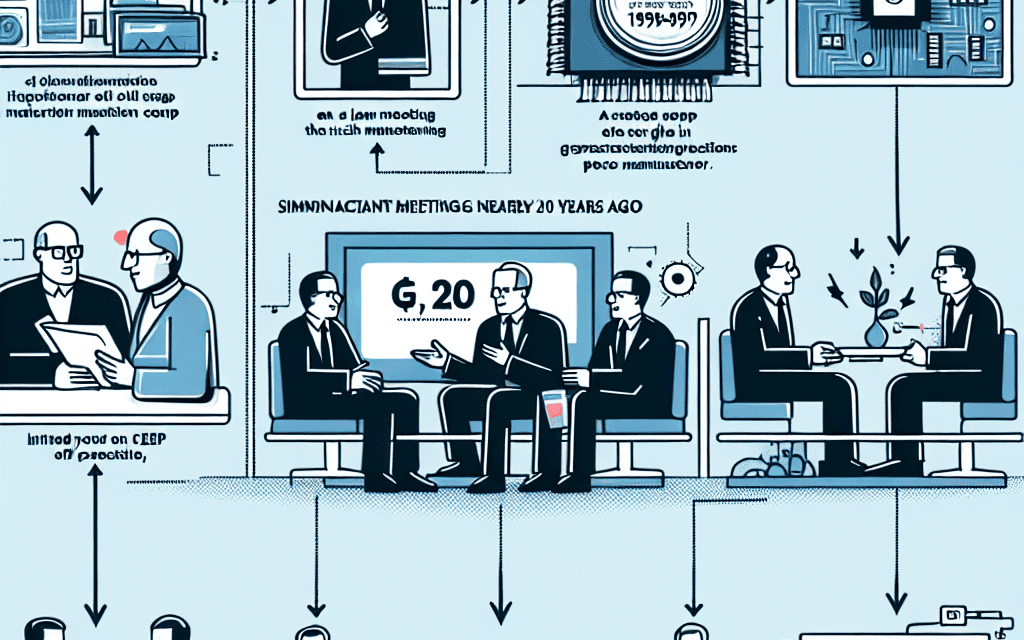“Intel’s Missed Leap: The Unseen Nvidia Acquisition That Could Have Redefined Tech History”
Introduction
Nearly two decades ago, Intel’s former CEO, Craig Barrett, made a bold move that could have dramatically reshaped the landscape of the semiconductor industry. In a strategic attempt to bolster Intel’s position in the burgeoning graphics processing market, Barrett sought to acquire Nvidia, a company that was rapidly gaining prominence for its innovative graphics technology. This potential acquisition, had it been successful, might have altered the competitive dynamics between Intel and its rivals, particularly in the realm of high-performance computing and graphics. However, the deal never materialized, leaving Nvidia to continue its independent trajectory, eventually becoming a dominant force in the industry. This episode remains a fascinating “what if” scenario in the history of technology mergers and acquisitions, highlighting the foresight and strategic ambitions of Intel’s leadership at the time.
The Untold Story: Intel’s Ex-CEO and the Nvidia Acquisition Attempt
In the annals of technology history, certain events stand out not only for their immediate impact but also for the tantalizing possibilities they represent. One such event, largely overshadowed by subsequent developments, is the attempted acquisition of Nvidia by Intel nearly two decades ago. This little-known episode, involving Intel’s former CEO, offers a fascinating glimpse into the strategic maneuvers of tech giants and the potential alternate realities of the semiconductor industry.
In the early 2000s, Intel was already a dominant force in the semiconductor industry, renowned for its microprocessors that powered the majority of personal computers worldwide. However, the company was keenly aware of the burgeoning importance of graphics processing units (GPUs), which were rapidly gaining traction not only in gaming but also in professional applications and scientific computing. Nvidia, a relatively young company at the time, was emerging as a leader in the GPU market, thanks to its innovative designs and forward-thinking approach.
Recognizing the strategic value of Nvidia’s technology and market position, Intel’s then-CEO initiated discussions aimed at acquiring the company. The rationale behind this move was clear: by integrating Nvidia’s cutting-edge GPU technology with Intel’s own processor expertise, the company could potentially create a formidable product lineup that would dominate both the CPU and GPU markets. Such a merger would have positioned Intel as an unrivaled leader in the semiconductor industry, with a comprehensive portfolio that spanned the entire spectrum of computing needs.
However, the negotiations between Intel and Nvidia were fraught with challenges. Cultural differences between the two companies, differing visions for the future, and concerns about maintaining Nvidia’s innovative spirit within the larger corporate structure of Intel all contributed to the complexity of the discussions. Moreover, there were significant financial considerations, as Nvidia’s valuation was rapidly increasing due to its success in the GPU market. These factors ultimately led to the collapse of the acquisition talks, leaving both companies to pursue their independent paths.
In the years that followed, Nvidia continued to grow and innovate, eventually becoming a dominant player not only in gaming but also in artificial intelligence and data center markets. Its GPUs became the backbone of AI research and development, cementing its status as a critical player in the tech industry. Meanwhile, Intel faced increasing competition from other semiconductor companies and struggled to maintain its leadership position in the face of rapidly evolving market dynamics.
Reflecting on this untold story, one cannot help but wonder how the tech landscape might have been different had the acquisition been successful. Would Intel have been able to leverage Nvidia’s technology to maintain its dominance in the semiconductor industry? Or would the integration challenges have stifled Nvidia’s innovative spirit, preventing it from achieving the breakthroughs that have defined its success? These questions remain speculative, yet they underscore the significance of strategic decisions in shaping the future of technology.
In conclusion, the attempted acquisition of Nvidia by Intel nearly two decades ago serves as a compelling reminder of the intricate interplay between corporate strategy, innovation, and market dynamics. While the deal ultimately fell through, its implications continue to resonate, offering valuable insights into the challenges and opportunities that define the ever-evolving world of technology. As we look to the future, this untold story remains a testament to the enduring impact of strategic foresight and the unpredictable nature of technological progress.
Behind the Scenes: Why Intel Wanted to Acquire Nvidia
In the early 2000s, the technology landscape was rapidly evolving, with companies vying for dominance in the burgeoning fields of graphics processing and computing power. During this period, Intel, a titan in the semiconductor industry, was led by then-CEO Craig Barrett. Under his leadership, Intel was exploring various strategic avenues to maintain its competitive edge and expand its influence in the tech world. One of the most intriguing moves considered by Barrett was the potential acquisition of Nvidia, a company that was beginning to make significant waves in the graphics processing unit (GPU) market.
At the time, Nvidia was emerging as a formidable player in the graphics industry, known for its innovative GPU designs that were quickly becoming essential components in personal computers and gaming consoles. The company’s focus on high-performance graphics technology was setting it apart from competitors, and its products were gaining traction among consumers and developers alike. Recognizing the potential of Nvidia’s technology, Intel saw an opportunity to bolster its own capabilities in the graphics domain, which was becoming increasingly important as demand for visually rich applications and games grew.
Intel’s interest in acquiring Nvidia was driven by several strategic considerations. Firstly, integrating Nvidia’s advanced GPU technology with Intel’s existing processor offerings could have created a powerful synergy, enabling Intel to offer more comprehensive and high-performance computing solutions. This would have positioned Intel to better compete against rivals like AMD, which was also making strides in the graphics and processor markets. Additionally, acquiring Nvidia would have allowed Intel to tap into the burgeoning gaming industry, which was experiencing rapid growth and presented lucrative opportunities for companies with strong graphics capabilities.
Moreover, the acquisition would have provided Intel with access to Nvidia’s talented pool of engineers and developers, who were at the forefront of graphics innovation. This infusion of expertise could have accelerated Intel’s own research and development efforts, potentially leading to breakthroughs in graphics technology and enhancing Intel’s overall product portfolio. Furthermore, by bringing Nvidia under its umbrella, Intel could have exerted greater control over the graphics market, potentially setting industry standards and influencing the direction of future technological advancements.
However, despite the potential benefits, the acquisition did not materialize. Several factors contributed to this outcome. For one, Nvidia’s leadership, under CEO Jen-Hsun Huang, was determined to maintain the company’s independence and continue its trajectory as a standalone entity. Huang’s vision for Nvidia was centered around innovation and growth, and he was reluctant to cede control to a larger corporation. Additionally, the financial implications of such an acquisition were significant, and Intel had to weigh the costs against the potential gains.
In retrospect, the decision not to pursue the acquisition may have been a pivotal moment for both companies. Nvidia continued to thrive independently, eventually becoming a dominant force in the GPU market and expanding into new areas such as artificial intelligence and data centers. Meanwhile, Intel remained a leader in the semiconductor industry, though it faced increasing competition in the graphics space. The story of Intel’s attempted acquisition of Nvidia serves as a fascinating example of the strategic decisions that shape the technology industry and highlights the complex interplay of vision, innovation, and market dynamics that drive corporate actions.
Strategic Moves: How Intel’s Ex-CEO Planned the Nvidia Acquisition
In the ever-evolving landscape of the semiconductor industry, strategic decisions made by key players can have profound implications on the market’s trajectory. Nearly two decades ago, a pivotal moment in this sector’s history unfolded when Intel’s then-CEO, Craig Barrett, considered acquiring Nvidia, a company that would later become a dominant force in graphics processing technology. This potential acquisition, had it materialized, might have significantly altered the competitive dynamics between these two tech giants and reshaped the semiconductor industry as we know it today.
During the early 2000s, Intel was already a formidable leader in the semiconductor market, primarily known for its dominance in central processing units (CPUs). However, the company was keenly aware of the growing importance of graphics processing units (GPUs), which were beginning to gain traction not only in gaming but also in professional applications and scientific computing. Nvidia, at the time, was emerging as a leader in GPU technology, demonstrating remarkable innovation and growth potential. Recognizing this, Barrett saw an opportunity to bolster Intel’s portfolio by integrating Nvidia’s cutting-edge graphics capabilities.
The strategic rationale behind this contemplated acquisition was multifaceted. Firstly, acquiring Nvidia would have allowed Intel to diversify its product offerings, thereby reducing its reliance on the CPU market. This diversification was particularly appealing given the increasing demand for high-performance graphics solutions across various sectors. Moreover, by bringing Nvidia under its umbrella, Intel could have leveraged synergies between CPU and GPU technologies, potentially leading to groundbreaking advancements in integrated computing solutions.
Furthermore, the acquisition would have provided Intel with a competitive edge over its rivals, particularly AMD, which was also making strides in the GPU space. By securing Nvidia’s expertise and intellectual property, Intel could have accelerated its own graphics technology development, thereby strengthening its market position. Additionally, the acquisition would have likely resulted in significant cost savings through economies of scale and streamlined research and development efforts.
However, despite the apparent strategic benefits, the acquisition did not come to fruition. Several factors contributed to this outcome. One key consideration was the potential regulatory hurdles that such a merger might have faced. Given the size and influence of both companies, antitrust concerns could have posed significant challenges, potentially delaying or even blocking the deal. Moreover, the financial implications of acquiring a rapidly growing company like Nvidia were substantial, and Intel may have been cautious about the risks involved.
In retrospect, the decision not to pursue the acquisition had far-reaching consequences. Nvidia continued to innovate independently, eventually becoming a powerhouse in the GPU market and expanding its influence into areas such as artificial intelligence and data centers. Meanwhile, Intel faced increasing competition in the graphics domain, prompting it to invest heavily in developing its own GPU technologies.
This episode serves as a compelling case study in strategic decision-making within the tech industry. It underscores the importance of foresight and adaptability in navigating the complexities of a rapidly changing market. While Intel’s ex-CEO Craig Barrett’s vision of acquiring Nvidia was never realized, the contemplation of such a move highlights the intricate interplay of strategic considerations that companies must weigh as they seek to maintain their competitive edge. As the semiconductor industry continues to evolve, the lessons from this near-acquisition remain relevant, offering valuable insights into the strategic maneuvers that shape the future of technology.
The Impact of a Failed Acquisition: Intel and Nvidia’s Diverging Paths

Nearly two decades ago, a pivotal moment in the tech industry unfolded when Intel’s then-CEO, Craig Barrett, attempted to acquire Nvidia, a move that could have dramatically altered the landscape of the semiconductor industry. This failed acquisition attempt has since become a significant point of reflection, illustrating how the trajectories of Intel and Nvidia have diverged over the years. Understanding the impact of this missed opportunity requires an exploration of the strategic intentions behind the acquisition, the reasons for its failure, and the subsequent paths taken by both companies.
At the time of the attempted acquisition, Intel was already a dominant force in the semiconductor industry, renowned for its microprocessors that powered the majority of personal computers. Nvidia, on the other hand, was emerging as a leader in graphics processing units (GPUs), a technology that was beginning to gain traction beyond its initial niche in gaming. Barrett’s interest in Nvidia was driven by a foresight into the growing importance of GPUs, not only in gaming but also in other computing applications such as scientific research and data processing. By acquiring Nvidia, Intel aimed to consolidate its position in the semiconductor market and expand its technological capabilities.
However, the acquisition never materialized, primarily due to disagreements over the valuation of Nvidia. At the time, Nvidia’s leadership, including its CEO Jensen Huang, believed in the immense potential of their technology and were unwilling to settle for a price that did not reflect their vision for the future. This impasse led to the collapse of negotiations, leaving Nvidia to continue its journey independently. In hindsight, this decision proved to be a turning point for both companies.
In the years following the failed acquisition, Nvidia capitalized on the burgeoning demand for GPUs, driven by advancements in gaming, artificial intelligence, and data centers. The company’s focus on innovation and strategic partnerships allowed it to capture significant market share and establish itself as a leader in the GPU industry. Nvidia’s success is exemplified by its role in the AI revolution, where its GPUs have become the backbone of machine learning and deep learning applications, propelling the company to new heights.
Conversely, Intel faced challenges in adapting to the rapidly changing technological landscape. While it maintained its dominance in the CPU market, the company struggled to make significant inroads into the GPU sector, a market that Nvidia had come to dominate. Intel’s attempts to develop its own discrete GPUs met with limited success, highlighting the missed opportunity of acquiring Nvidia when it had the chance. This divergence in fortunes underscores the long-term impact of strategic decisions made nearly two decades ago.
Reflecting on this failed acquisition, it becomes evident that the paths of Intel and Nvidia were shaped by a combination of foresight, strategic vision, and the ability to adapt to evolving market demands. While Intel remains a powerhouse in the semiconductor industry, Nvidia’s rise to prominence in the GPU market serves as a testament to the importance of recognizing and seizing opportunities. As the tech industry continues to evolve, the story of Intel’s attempted acquisition of Nvidia serves as a reminder of how pivotal moments can define the future trajectories of companies, influencing their roles in shaping technological advancements for years to come.
Lessons Learned: What Intel’s Attempted Nvidia Acquisition Teaches Us
In the ever-evolving landscape of the technology industry, strategic decisions made by companies can have profound implications on their future trajectories. Nearly two decades ago, Intel, a titan in the semiconductor industry, attempted to acquire Nvidia, a company that was then emerging as a formidable player in the graphics processing unit (GPU) market. This bold move, led by Intel’s then-CEO, offers valuable lessons on the complexities of corporate strategy, the importance of foresight, and the unpredictable nature of technological innovation.
At the time of the attempted acquisition, Intel was already a dominant force in the microprocessor market, while Nvidia was gaining momentum with its innovative GPU technology. Intel’s interest in Nvidia was driven by a desire to diversify its product offerings and strengthen its position in the burgeoning field of graphics processing. The acquisition, if successful, would have allowed Intel to integrate Nvidia’s cutting-edge technology into its own product lines, potentially reshaping the competitive landscape of the semiconductor industry.
However, the deal never materialized, and Nvidia continued to operate independently. In retrospect, this failed acquisition attempt underscores the importance of recognizing and adapting to emerging trends in technology. While Intel was focused on maintaining its dominance in the CPU market, Nvidia was pioneering advancements in GPU technology that would later become critical for applications such as gaming, artificial intelligence, and data processing. This highlights the necessity for companies to not only focus on their current strengths but also to anticipate and invest in future technological shifts.
Moreover, the attempted acquisition serves as a reminder of the challenges inherent in mergers and acquisitions, particularly in the technology sector. Integrating two distinct corporate cultures, aligning strategic goals, and managing potential regulatory hurdles are just a few of the complexities that can arise. In Intel’s case, the potential cultural clash between its established corporate environment and Nvidia’s innovative, fast-paced ethos may have posed significant integration challenges. This illustrates the need for companies to conduct thorough due diligence and carefully consider the long-term implications of such strategic moves.
Additionally, the outcome of this attempted acquisition highlights the unpredictable nature of technological innovation and market dynamics. While Intel remained a leader in the CPU market, Nvidia’s focus on GPUs allowed it to capture significant market share and become a key player in the tech industry. This serves as a testament to the importance of agility and adaptability in a rapidly changing environment. Companies must be prepared to pivot and embrace new opportunities as they arise, rather than relying solely on past successes.
Furthermore, Intel’s experience with Nvidia underscores the value of strategic partnerships and collaborations. While the acquisition did not come to fruition, both companies have since engaged in various collaborations that have benefited the industry as a whole. This demonstrates that even when acquisition attempts fail, there are often alternative avenues for cooperation that can lead to mutual growth and innovation.
In conclusion, Intel’s attempted acquisition of Nvidia nearly two decades ago offers a wealth of lessons for companies navigating the complex and dynamic technology landscape. It emphasizes the importance of foresight, adaptability, and strategic planning, while also highlighting the challenges and opportunities inherent in mergers and acquisitions. As the tech industry continues to evolve, these lessons remain as relevant as ever, guiding companies in their pursuit of innovation and growth.
Industry Repercussions: How the Attempted Acquisition Shaped Tech Giants
Nearly two decades ago, a bold move by Intel’s then-CEO, Craig Barrett, could have dramatically altered the landscape of the technology industry. In the early 2000s, Barrett attempted to acquire Nvidia, a company that was beginning to make waves in the graphics processing unit (GPU) market. Although the acquisition never materialized, the implications of this attempted merger have had lasting effects on the tech giants we know today. Understanding the context and consequences of this near-acquisition provides valuable insights into the strategic decisions that have shaped the industry.
At the time, Intel was already a dominant force in the semiconductor industry, primarily known for its central processing units (CPUs). However, the company recognized the growing importance of GPUs, which were becoming essential for gaming and other graphics-intensive applications. Nvidia, on the other hand, was a rising star, having established itself as a leader in the GPU market with its innovative designs and forward-thinking approach. The potential acquisition of Nvidia by Intel was seen as a strategic move to consolidate Intel’s position in the semiconductor market and to expand its influence into the burgeoning field of graphics processing.
Despite the potential synergies, the acquisition did not come to fruition. Various factors contributed to this outcome, including regulatory concerns, cultural differences between the two companies, and Nvidia’s desire to maintain its independence. The failure of the acquisition attempt forced both companies to chart their own paths, leading to significant developments in their respective areas of expertise. For Intel, the decision to focus on its core competencies in CPU development allowed it to maintain its leadership position in the market. However, the missed opportunity to integrate Nvidia’s GPU technology meant that Intel had to invest heavily in developing its own graphics solutions, a challenge that continues to this day.
Conversely, Nvidia’s decision to remain independent proved to be a pivotal moment in its history. Free from the constraints of a larger corporate structure, Nvidia was able to innovate rapidly and expand its product offerings beyond traditional GPUs. This independence allowed Nvidia to explore new markets, such as artificial intelligence and data centers, where its GPU technology has become indispensable. As a result, Nvidia has grown into one of the most influential companies in the tech industry, with a market capitalization that rivals that of Intel.
The attempted acquisition also had broader implications for the technology industry as a whole. It highlighted the growing importance of GPUs and the need for companies to adapt to changing technological trends. This realization spurred increased investment in GPU development across the industry, leading to advancements that have fueled the growth of sectors such as gaming, virtual reality, and machine learning. Furthermore, the near-acquisition underscored the significance of strategic partnerships and acquisitions in shaping the competitive landscape of the tech industry.
In conclusion, while Intel’s attempted acquisition of Nvidia nearly 20 years ago did not succeed, its impact on the industry has been profound. The decision set both companies on trajectories that have defined their roles as tech giants today. Intel’s continued focus on CPUs and Nvidia’s expansion into new markets have not only shaped their individual successes but have also influenced the broader technological ecosystem. As the industry continues to evolve, the lessons learned from this near-acquisition remain relevant, serving as a reminder of the strategic decisions that can alter the course of technological innovation.
Revisiting History: The Significance of Intel’s Bid for Nvidia 20 Years Later
Nearly two decades ago, a pivotal moment in the tech industry unfolded that could have dramatically altered the landscape of semiconductor technology. Intel, a titan in the microprocessor industry, attempted to acquire Nvidia, a company that was then emerging as a leader in graphics processing units (GPUs). This bold move, spearheaded by Intel’s then-CEO, Craig Barrett, was a strategic maneuver aimed at consolidating Intel’s dominance in the semiconductor market. Although the acquisition ultimately did not materialize, revisiting this historical bid offers valuable insights into the strategic decisions that have shaped the current dynamics of the tech industry.
At the time of the attempted acquisition, Intel was already a formidable force in the microprocessor market, primarily due to its x86 architecture, which powered the majority of personal computers. However, the company recognized the growing importance of GPUs, which were becoming essential for rendering complex graphics in video games and other applications. Nvidia, on the other hand, was rapidly gaining traction with its innovative GPU designs, which were not only enhancing gaming experiences but also beginning to find applications in scientific computing and data analysis. The potential synergy between Intel’s processing power and Nvidia’s graphics expertise was evident, and the acquisition could have positioned Intel as an unrivaled leader in both CPU and GPU technologies.
Despite the apparent strategic fit, the acquisition faced significant hurdles. One of the primary challenges was the cultural and operational differences between the two companies. Intel, with its established corporate structure and processes, contrasted sharply with Nvidia’s more agile and innovative approach. Integrating these disparate cultures posed a significant risk, potentially stifling Nvidia’s creative edge, which was crucial to its success. Moreover, regulatory concerns loomed large, as such a merger would have attracted scrutiny from antitrust authorities wary of Intel’s already dominant market position.
In retrospect, the failure of the acquisition bid had profound implications for both companies and the broader tech industry. For Intel, the inability to secure Nvidia meant that it missed an opportunity to diversify its product offerings and strengthen its position in the burgeoning GPU market. This gap became more pronounced as GPUs evolved beyond graphics rendering to become integral components in artificial intelligence, machine learning, and high-performance computing. Nvidia, unencumbered by the constraints of a merger, continued to innovate and expand its influence, eventually becoming a leader in AI and data center solutions.
The attempted acquisition also underscores the importance of strategic foresight in the tech industry. Intel’s recognition of the potential of GPUs was prescient, yet the execution of its strategy fell short. This episode serves as a reminder that while identifying emerging trends is crucial, the ability to effectively integrate and capitalize on them is equally important. As the tech landscape continues to evolve, companies must remain agile and adaptable, learning from past endeavors to navigate future challenges.
In conclusion, Intel’s bid to acquire Nvidia nearly 20 years ago remains a significant episode in the history of the tech industry. It highlights the complexities and challenges of strategic acquisitions, particularly in a rapidly changing technological environment. While the acquisition did not come to fruition, its legacy persists, offering lessons in strategic planning, cultural integration, and the foresight needed to thrive in an ever-evolving market. As we reflect on this historical moment, it becomes clear that the decisions made in the past continue to resonate, shaping the trajectories of industry leaders and influencing the future of technology.
Q&A
1. **Who was Intel’s CEO nearly 20 years ago?**
Craig Barrett was Intel’s CEO nearly 20 years ago.
2. **What company did Intel’s ex-CEO attempt to acquire?**
Intel’s ex-CEO attempted to acquire Nvidia.
3. **When did the attempted acquisition take place?**
The attempted acquisition took place in the early 2000s.
4. **Why did Intel want to acquire Nvidia?**
Intel wanted to acquire Nvidia to strengthen its position in the graphics and semiconductor markets.
5. **What was the outcome of the attempted acquisition?**
The acquisition did not go through, and Nvidia remained independent.
6. **How did Nvidia’s leadership respond to the acquisition attempt?**
Nvidia’s leadership, including CEO Jensen Huang, was not interested in selling the company.
7. **What impact did the failed acquisition have on Intel and Nvidia?**
The failed acquisition allowed Nvidia to continue its growth independently, eventually becoming a leader in graphics technology, while Intel continued to focus on its core CPU business.
Conclusion
Nearly 20 years ago, Intel’s then-CEO, Craig Barrett, attempted to acquire Nvidia, a move that could have significantly altered the landscape of the semiconductor industry. At the time, Nvidia was emerging as a leader in graphics processing technology, a field that has since become crucial for various applications, including gaming, AI, and data centers. The acquisition, had it been successful, might have positioned Intel as a dominant force in both CPU and GPU markets, potentially staving off the competitive pressures it faces today from Nvidia and other companies. However, the deal did not materialize, allowing Nvidia to grow independently and become a formidable competitor. This missed opportunity highlights the importance of strategic foresight in the rapidly evolving tech industry and underscores how pivotal decisions can shape the future trajectories of major companies.





